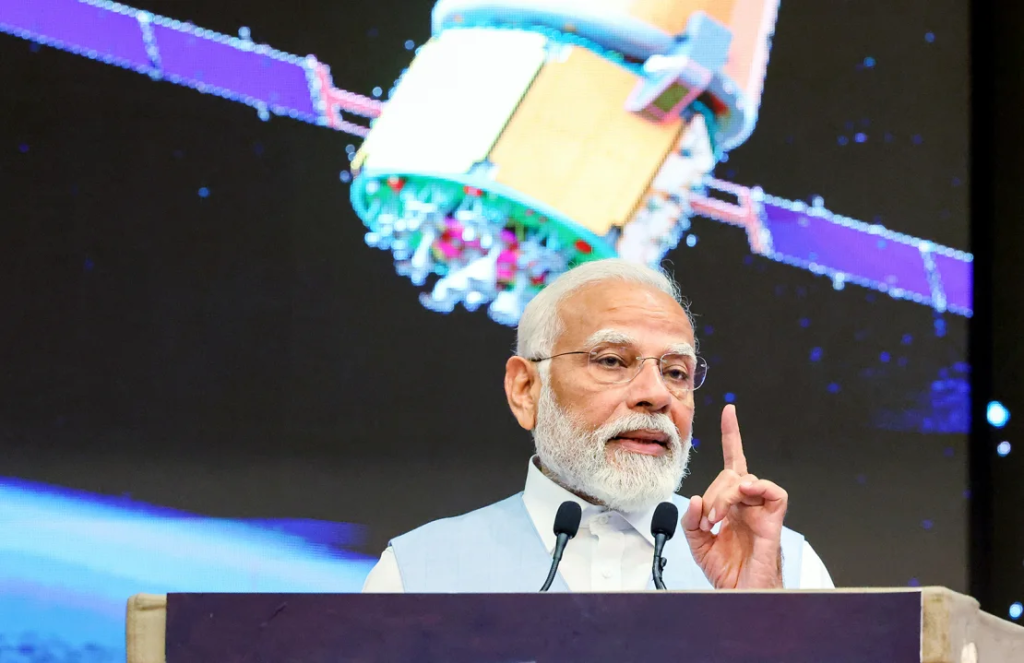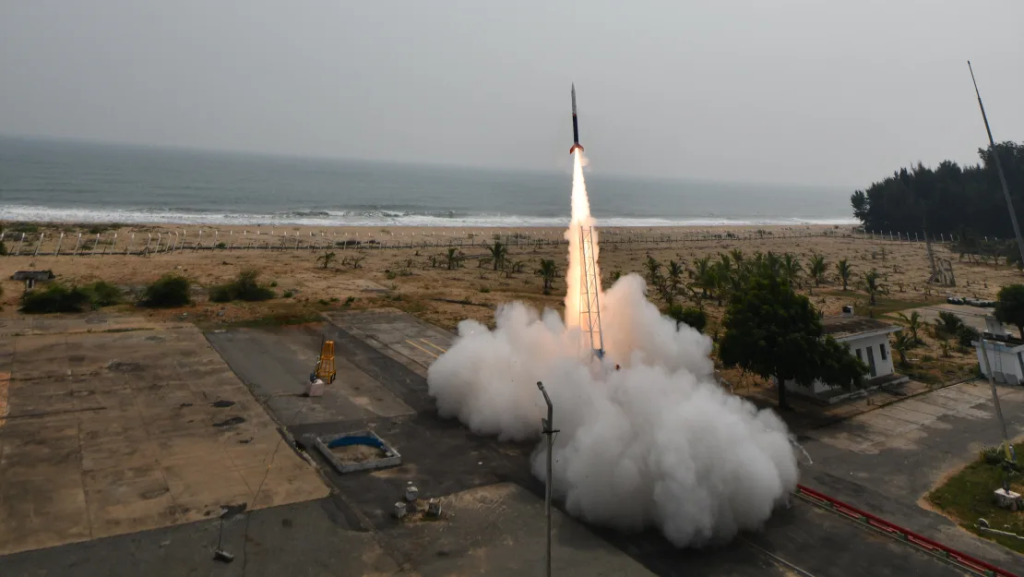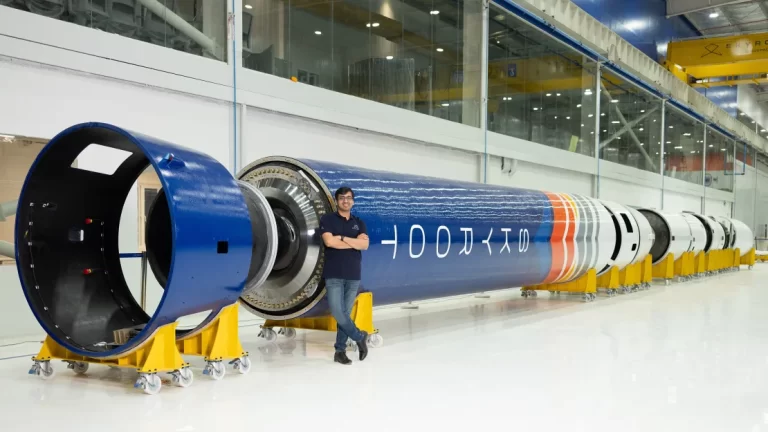India is one of the world’s top spacefaring nations. It is the first Asian country to reach Mars orbit, and the fourth on the planet to take a spacecraft to the moon, landing closer to the south pole, known for its cratered terrain, than anyone else has.
But its private sector has played a limited role in space exploration, acting mostly as suppliers and vendors for its national space agency, the Indian Space Research Organization (ISRO).
That’s changing quickly, owing to a raft of government reforms aiming to boost private participation in the space sector. In the United States, the proliferation of private companies like Elon Musk’s SpaceX have boosted Washington’s space ambitions by driving down costs.
Now Indian homegrown startups like Skyroot Aerospace, which launched the country’s first private rocket in 2022, are leading the charge to commercialize India’s space sector and bolster its status as a space superpower.
Inside a sleek rocket hanger in the southern city of Hyderabad, the company is preparing for lift-off of the seven-story tall Vikram-1 rocket, which will take India’s first privately launched satellites into orbit.
“That’ll be a major milestone for us,” Pawan Chandana, a former ISRO scientist who co-founded Skyroot Aerospace in 2018, told CNN. “Very few companies globally are able to make it to orbit yet.” India is pushing pioneering national initiatives, including plans to have its own space station by 2035 and to put an Indian astronaut on the moon by 2040.
Meanwhile, Prime Minister Narendra Modi, who is currently running for his third consecutive term, has made a major push to commercialize space activity in recent years, including allowing private enterprise to take part and easing approvals for foreign investment into the space sector.
Small satellites, big opportunity
Companies around the world are catapulting thousands of satellites into low Earth orbit (LEO), which extends to an altitude of about 2,000 kilometers (1,200 miles), to form mega-constellations: groups of small satellites that work together to beam broadband Internet to terrestrial users.
According to analytics firm BryceTech, 96% of spacecraft launched in 2022 were small satellites, up from 61% in 2013.
That’s driving exponential growth. The global space economy was worth $630 billion in 2023, according to a report by McKinsey & Company and the World Economic Forum, and it could grow to $1.8 trillion by 2035.
It’s the small satellite market that Skyroot wants to capture, with plans to offer customized launches for satellites under 500 kilograms (1,100 pounds).
Organizations’ satellites often piggyback onto “rideshare” missions. Last year, for example, one SpaceX journey — powered by its Falcon 9 rocket, which can carry 22,000 kilograms (48,500 pounds) into LEO — launched 51 small satellites into orbit for multiple companies.
But there’s often a waiting period to hitch a ride, and satellites can only go where the rocket is heading. That may be disadvantageous for a satellite that wants to reach a particular orbit, to observe a certain part of the planet.
The model does provides advantages. SpaceX says the cost of getting a 500-kilogram (1,100 pound) payload into LEO is about $6,000 per kilogram.

“It’s really very, very competitive what SpaceX is now offering,” says Susmita Mohanty, director general of Indian think-tank Spaceport Sarabhai.
Skyroot wants to offer dedicated launches for $20,000 per kilogram, which is much more expensive than SpaceX’s less bespoke service. (Chandana says that mass production and better technology may enable further cost reductions).
Chandana compares SpaceX’s ridesharing missions as “a train to go to space” and Skyroot’s operations as “cabs to get into space, where we take satellites to their customized locations.”
He adds: “We don’t directly compete with SpaceX, because SpaceX is into bigger vehicles and satellites … and what we are into is customized launch solutions.” Once prices drop, there will be more interest in “people wanting to choose dedicated launches without compromising on going for a rideshare mission,” he said.
Customized launches might be useful for those who want to send smaller payloads aiming to reach “a diverse amount of orbits” that might not be possible to get to by ridesharing, says Kari Bingen, director of the Aerospace Security Project at the Center for Strategic and International Studies, a think-tank based in the US.
That could be useful for commercial companies, academic institutions or governments that are willing to pay the price, she adds.
Chandana is optimistic he can make it more affordable, noting the “frugality in the DNA” of India’s space program. (The country’s Mars orbiter budget was just $74 million. Modi has pointed out that it cost less than the Hollywood sci-fi thriller “Gravity.”)
Chandana adds that the company aims to build a reusable rocket eventually, a capability which has helped SpaceX reduce launch costs.
Hurdles to clear
India is now home to almost 200 space startups, up from just one in 2014, according to a report published by Deloitte in 2023. Over the same period, private investment into those companies topped $200 million. Skyroot has already raised $95 million, with backers like Singapore sovereign wealth fund GIC. That makes it India’s most-funded space startup, according to data platform Tracxn.
But the company has work to do to reach profitability. It needs to demonstrate that it can consistently reach orbit, before interest “will turn into contracts, which will help us scale,” says Chandana. Yet spots on Vikram-1 are fully booked, with a mix of domestic and international clients.
As Indian space startups mature over the coming years, he expects the government to become a customer, enabling further growth. Many private space companies source income from governments, including Space X, which has raked in billions of dollars from US government contracts.
India’s government allocated just under $1.6 billion to develop its space prorgram in its interim 2024 budget. By comparison, NASA received $24.9 billion for 2024.
“Unless and until the government backs up the reforms with significant funding coming from India itself, it will be difficult for us to rival the development of the US market or the Chinese market,” says Mohanty.

She adds that for Indian startups to play a meaningful role in the global marketplace, “they need to go beyond servicing our own space agency’s domestic mandate and start bidding for contracts.” Chandana sounds up for the challenge. “We want to become globally [one of the] top three launch companies,” he says. “My fascination for rockets has become an obsession.”


